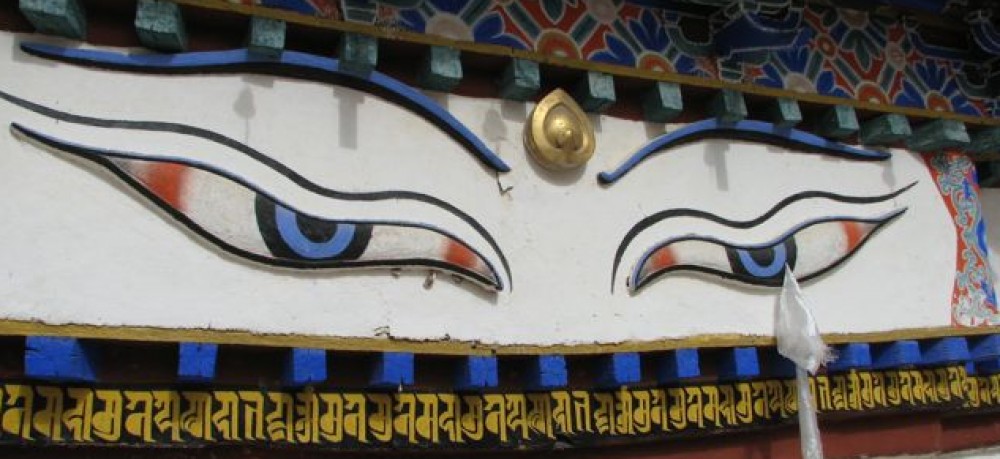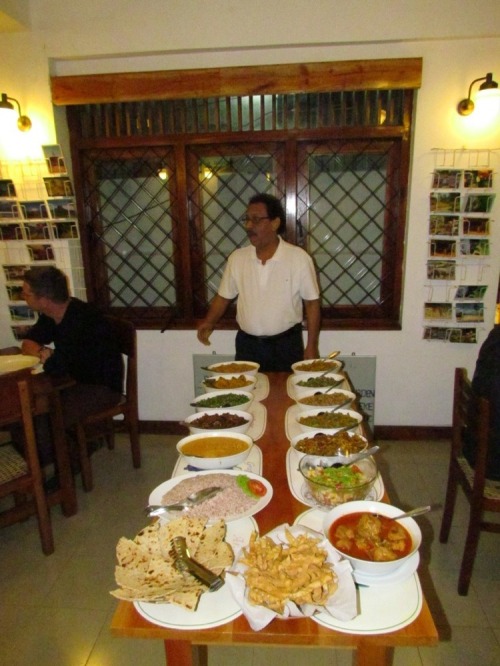The picture above is of Faiesz’s nightly Sri Lankan curry dinner at the Sharon Inn in Kandy. I thought I should fill you in on the cuisine of the country, which is surprisingly nice. Traditionally a Sri Lankan curry dinner consists of rice, and a number of smaller dishes, usually including either chicken or fish in a spicy sauce, and between 5 and 12 vegetable dishes and dahl, accompanied by one or more hot sambols, my favourite being coconut. You are served a large dish of rice surrounded by smaller plates of the meat and vegetables, and you take a big portion of the rice and surround it with dollops of the other dishes, seasoned with a bit of the spicy sambol. All the vegetable dishes are seasoned with different spices and cooked in a sauce.
Faiesz’s is extraordinary, being at least 12 different dishes, and different every night (we ate there 6 times and it was excellent each time) but we have been served 5 or 6 side dishes in very ordinary little guest houses, all very interestingly spiced. I think maybe they tone the food down for the tourists, as a surprising number of them are very timid eaters, so we actually ask for it spicy in order to get some kick to it. Some examples of the vegetables are: eggplant (my favourite, every version I’ve had is just addicting) pumpkin, breadfruit, bitter gourd (deep fried it isn’t bitter) snake melon, banana flower, lots of kinds of beans, carrots, and last night a whole dish of garlic, which is especially prepared so it is mild and not garlicky. Usually we get papadums with it, but Faiesz always gave us coconut roti and hoppers (like very thin rice flour pancakes but shaped like bowls.) You are supposed to eat with your fingers, picking up a bit of rice and coating it with one of the curried dishes before popping it into your mouth. We have tried valiantly to master the technique in the past, in India, and it is surprisingly difficult to accomplish without coating your whole hand and forearm with the sauce. They just hand foreigners forks here so we have forgone more attempts with the hands. There are a lot of bakeries here, and they seem to be the lunch venue of choice. They make what they call “short eats” which are all manner of bun like concoctions with various savoury or sweet things inside them. Some are kind of puff pastry, others are deep fried, some are more like pie crust. The usual way to serve them is to put a large platter of assorted ones in the middle of the table and you just take what you want and are charged for what you eat. Tea comes with everything, and it is dark tea that they grow here, and pretty much demands milk at least if not sugar. Sri Lankan breakfast consists of string hoppers, kind of a rice vermicelli nest, over which you ladle chicken or fish curry, and vegetables. I have always had trouble eating dinner for breakfast (I still shudder when thinking of my Indonesian breakfasts) so I am afraid we get the Western option — a huge platter of dry toast, two eggs and fruit with tea or coffee but the coffee is pretty vile so we have switched to tea. So we are definitely not starving! Lucky we walk a lot. When we are out for our day hikes we picnic on crackers, canned cheese, and bananas which we prefer to a huge heavy lunch anyway. We had a most scenic and restful 7 hour train journey from Kandy to Ella. Faiesz got us tickets in the “Observation” car which meant we had comfortable assigned seats and big windows to look out of. Beautiful scenery as you climb from Kandy up into the hill areas, traveling through plantations of fruit and rice paddies at first, then miles and miles of tea plantations as we gained height. The trains are old, and I am sure a lot of the track dates to before independence, so that factor combined with the switchbacks necessary to gain height means it is very sedate and slow, probably 25 to 30 kph most of the way. This hill train is considered a “must do” for travelers but most Sri Lankans use it too, much more comfortable than the overcrowded buses — though when we experienced 3rd class between Ella and Haputale the crush was the same as the bus. In Ella we did two main hikes, the most noteworthy being to Ella Rock from where the views were panoramic. As in all hot countries, hill stations are beloved, especially during the really hot months of April and May. People really love the fresh air and the invigorating climate. I always have mixed feelings about digging to the bottom of my pack for my fleece jacket and putting on all the warm clothes I have brought and then wearing them day and night until we descend. Great temperature for hiking though. After a few days in Ella we came on here to Haputale, a small, very Tamil town hanging on the edge of a hillside surrounded by tea plantations. It is really cute to see men in sarongs and flip flops wandering around in down jackets and balaclavas, the women similarly attired over their saris. All the men on our all male guest house staff (Muslim establishment) wear business shirts, dress pants, leather shoes, and toques, at all times. By the way this is a very nice guest house, vast improvement over the grubby conditions in Ella, and we have a balcony overlooking the most outstanding view — on a clear day you can see the ocean 80 km away, so they say. We had a great day today. We took a tuk tuk up to Lipton’s Seat, a vantage point with a 360 degree view where Sir Thomas Lipton used to sit and survey his vast tea plantations. Lipton is responsible for the English fondness for strong black tea as he decided to set up his own tea plantations to supply his chain of grocery stores in England. The high country tea here is much darker than the Indian brews formerly favoured by the English. We have never in all the tea countries we have visited, and that is a few, seen anything like the scale of tea growing here. The plantations are vast and extremely organized, with signs indicating the year the bushes were planted (many around here are dated 1850) the last pruning, the expected yield, etc etc in each sub area of the plantations. We walked back from Lipton’s Seat, about 2 1/2 hours down to the tea factory where the tea that was being picked is processed. There we had an interesting tour — much much more organized than tea factories we saw in India and Guatemala, in China the process is much different. Here the tea goes from green leaf to finished product in 24 hours. As we walked, we watched the tea being picked by an army of tiny ladies with bags suspended from their foreheads hanging over their backs. They pluck only the bud and the top two leaves, and in the rainy season every bush has to be picked twice a week, once a week in the dry season. If you saw what a huge area these plantations cover, and the extremely steep terrain, you would find it hard to credit that it is possible to cover the place once a month let alone twice a week. Tea plucking is completely a hands on operation, it is had to see how it could be mechanized. There are over 300,000 tea pluckers at work in Sri Lanka, all Tamils from South India imported by the British nearly 200 years ago. They have to pick 18 kilos a day (many sacks, think about how light the leaves are) and for that they are paid 450 rupees, about $4.00. They live on the estate, which has its own hospital and schools, and they all seem to grow massive vegetable gardens around their tiny houses. This is not a cheap country, that is a tiny daily wage. These are truly “estates” in the old sense. However, when we walked out of the estate area and got back into true rural homes, we immediately were struck with how much less well kept the kids were, runny noses and impetigo, and the ditches were running with stinky water. The estates make a big thing of being environmentally sound, we even saw sorting for recycling, and there are signs everywhere admonishing people not to pollute the streams (think of the health of your brother and sister down stream..) There were also billboards with all the rules for the health and welfare of the workers, and the employment standards, fascinating reading. Lots of rules about the spraying of chemicals — who can do it (women and teenagers forbidden) what you have to wear to do it, and how to avoid the “buffer” zones with the spray. We saw special shower stations for decontaminating afterwards. I have seen people spraying, and they wear neither shoes nor face masks though. We met some very nice people at our guesthouse in Ella and one couple, who are from Ottawa, and who spend six months of every year traveling, turned up here yesterday. We are off to meet them for dinner at their guest house (no restaurants in this town) which will be nice. We have met a lot of pleasant people on this trip. I knew this woman had to be a former teacher when she offered me some information on places to stay on the coast where we head next, and then handed me 5 green sticky notes with their names, websites, email addresses and phone numbers all done in meticulous printing. We are off to Kataragama on the bus tomorrow, heading toward Tissamaharama aka Tissa. Kataragama is notable only for its Hindu temple at which a spectacular puja takes place every evening. From Tissa we plan to visit a large nature preserve (with resident leopards and wild elephants) and two bird sanctuaries. Will keep you posted.Anything is Possible
Doug and Carol love to travel!

